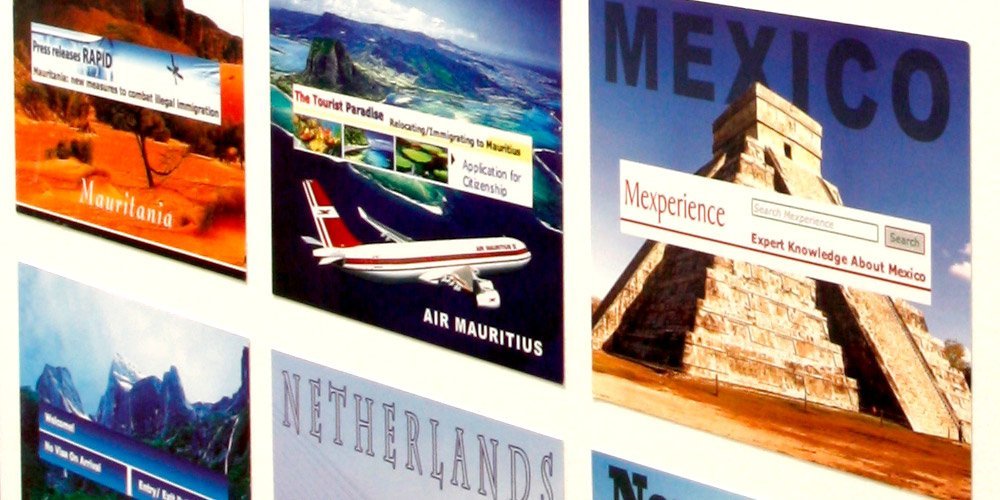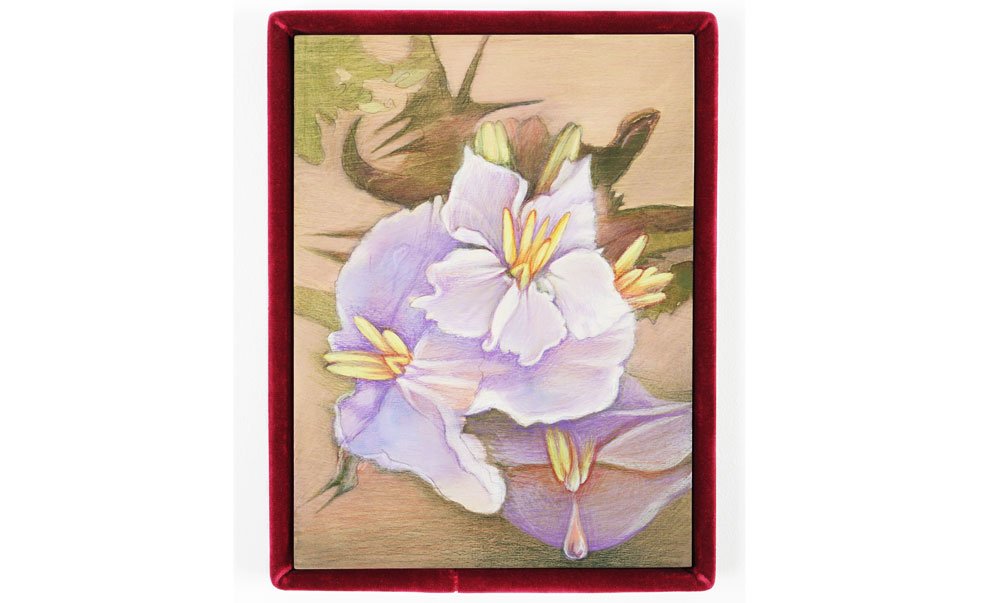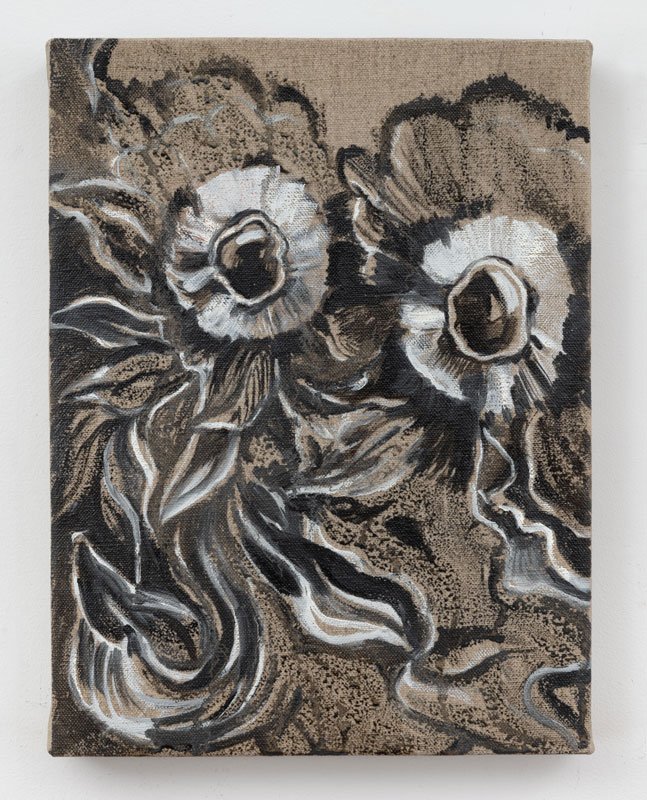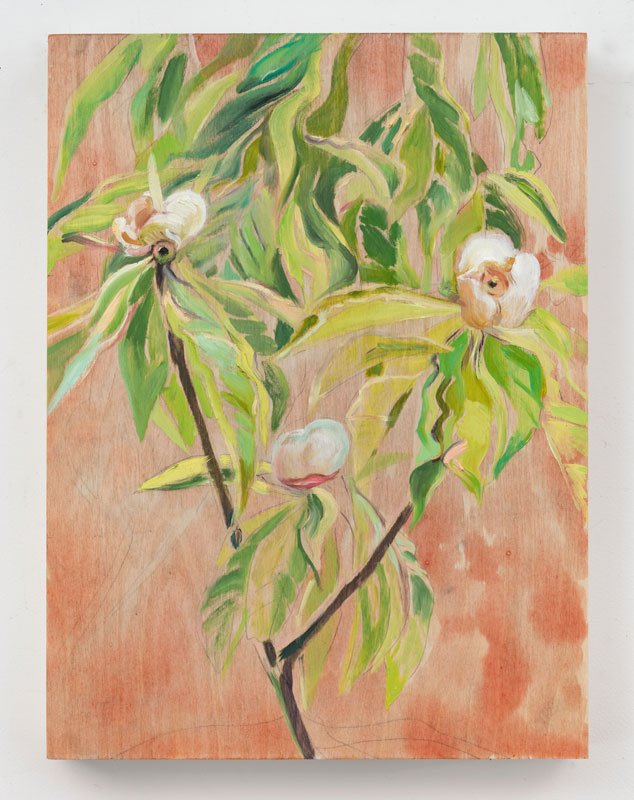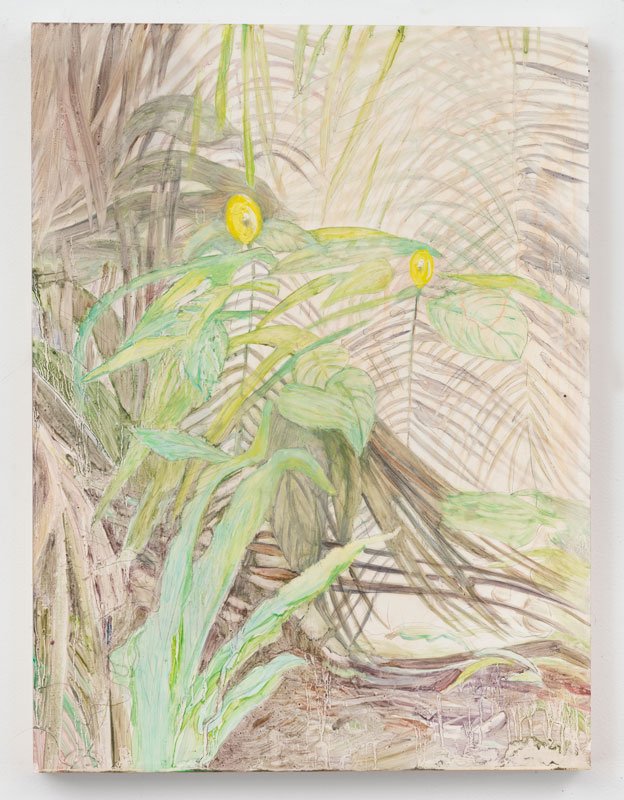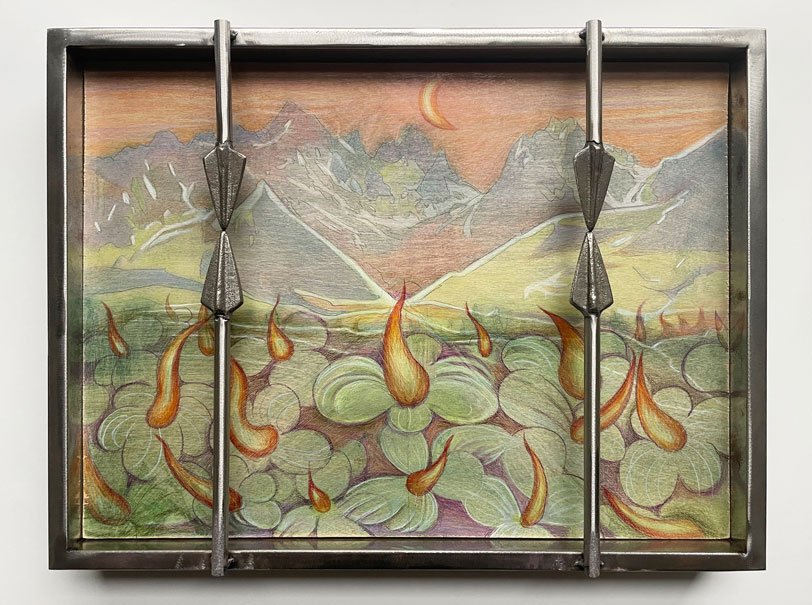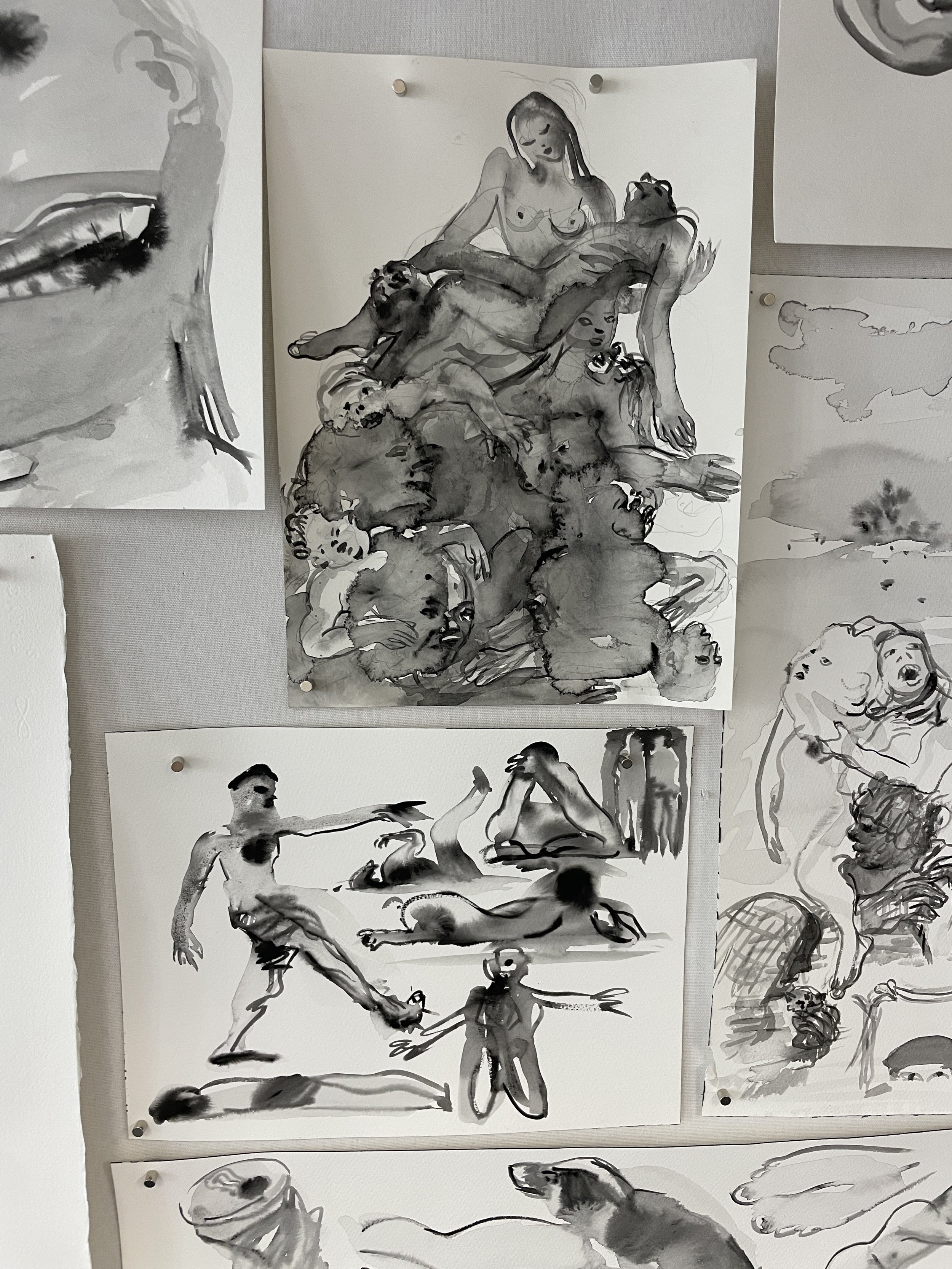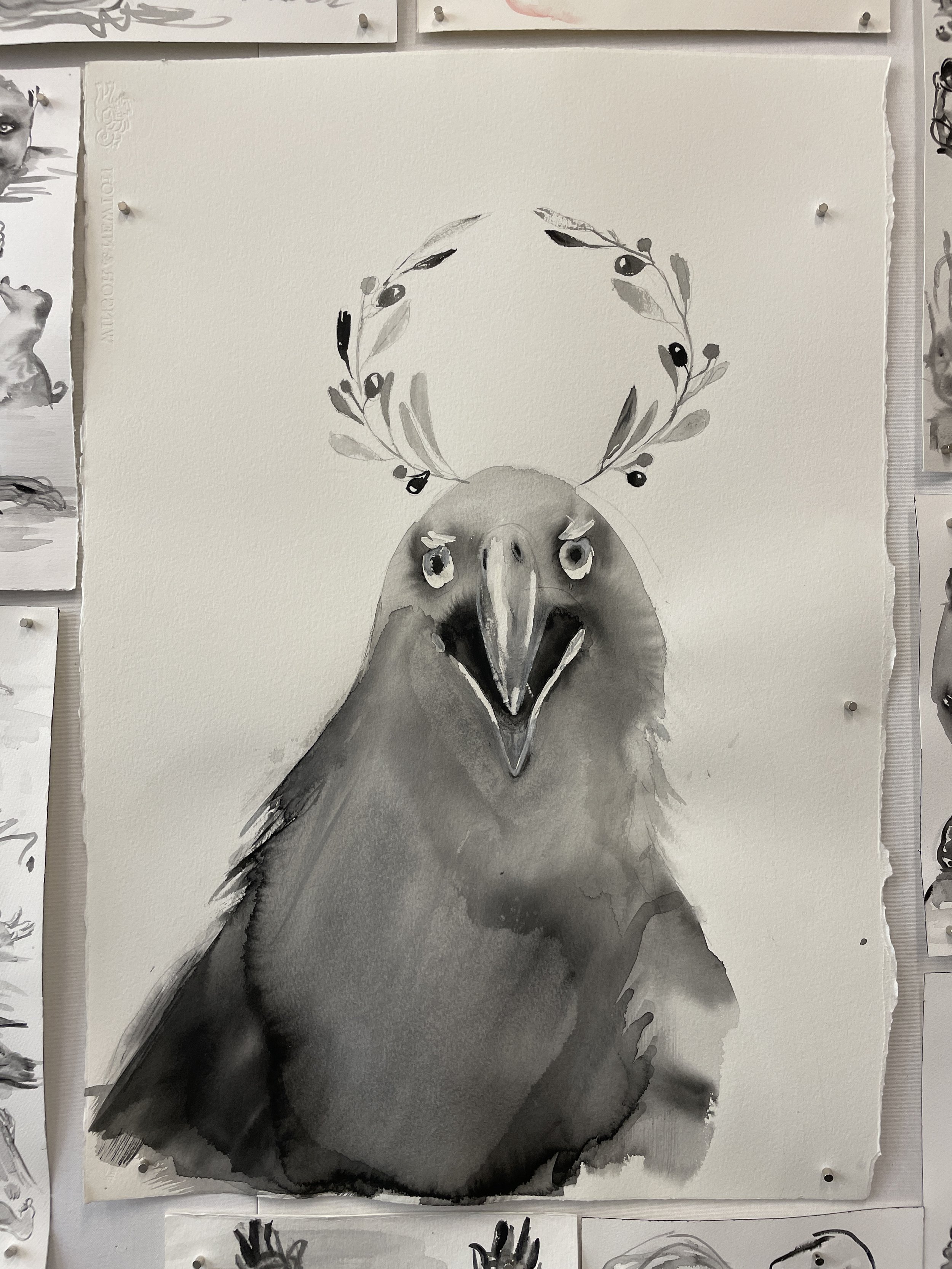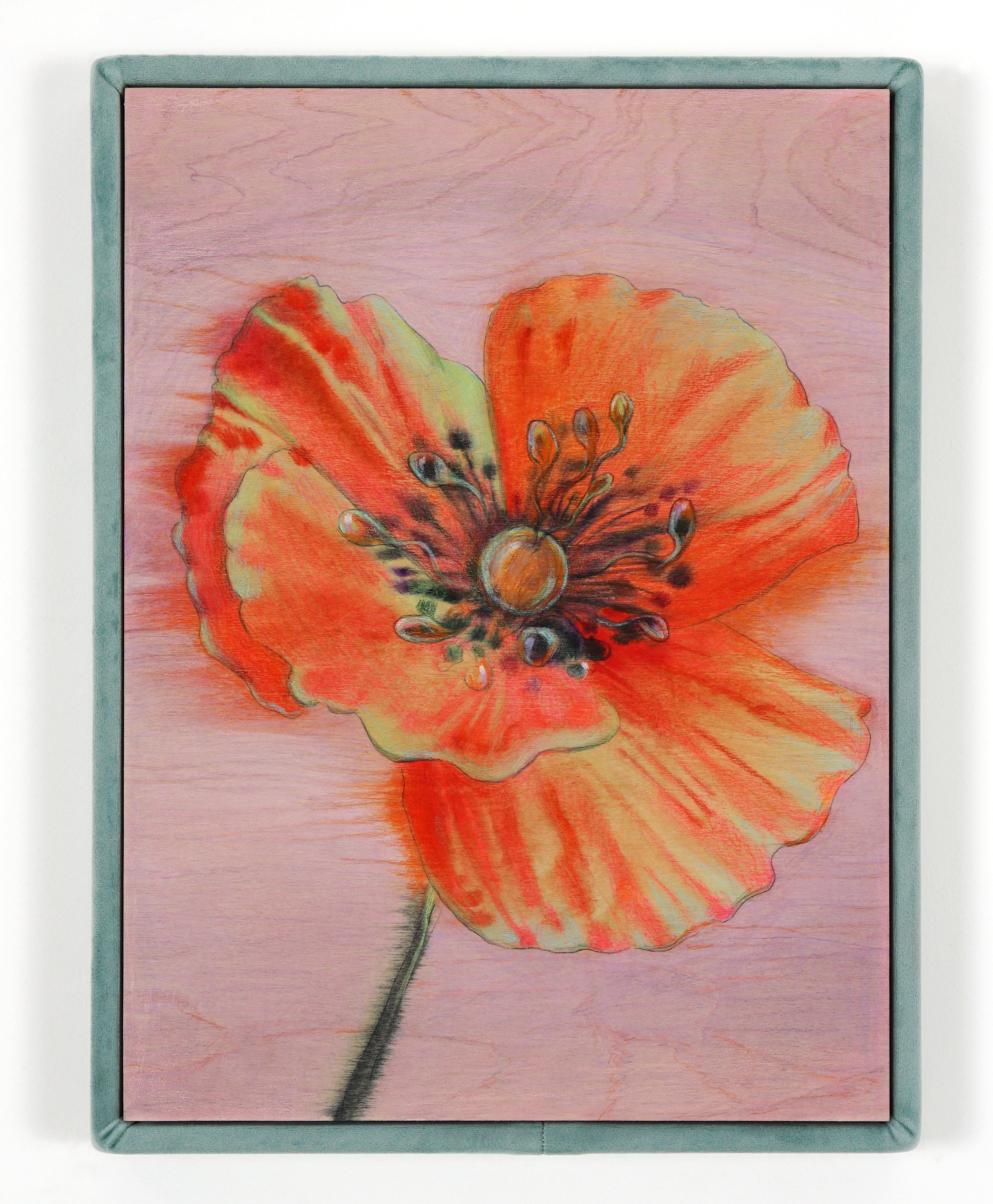INTERVIEW: Alina Bliumis "We are Beaten but We are not Broken" REFORM.NEWS
BRUISES, SITUATIONS at NADA Villa Warsaw May 22–25, 2025
First, there is the old truth that “In the beginning is the body, ” with its desires, its powers, its manifold form of resistance to exploitation. As is often recognized, there is no social change, no cultural or political innovation that is not expressed through the body, no economic practice that is not applied to it.
- Silvia Federici “Beyond the Periphery of the Skin” 2020
The body is a document of social struggles. In the Alina Bliumis’ native country of Belarus, the nation united in response to the rigged election of 2020. Protesters who met severe police brutality shared their bruises and resulting scars. Having faced aggressive measures of suppression and unjust detainment across various media platforms, the opposition sought to bring public awareness to their human rights abuses in hopes of achieving future justice. These events triggered Bliumis’ watercolor on linen series titled Bruises. Each bruise painting is numbered in reference to statistics of human suffering, citing numbers of political prisoners and refugees. The artist represents the bruises as abstract patches of watercolor allowing the pigment to bleed into the weave of the linen in a style reminiscent of Color Field painting. Bliumis engages the expressionist style’s association with making an emotional impact through clarity of color and form with an emphasis on celebrating individual expression and freedom of subjectivity. Her paintings are spatial and alive to endow an immortality to the feelings and sensations that underlie these important moments throughout our own personal and collective history.
A Painting For A Family Dinner is included in At the table. Eating and Drinking in Contemporary Art, Museum Ostwall at the Dortmunder U, Germany, May 8-July 20, 2025
At the Table. Eating and Drinking in Contemporary Art
Curated by Christina Danick and Michael Griff
Museum Ostwall at the Dortmunder U, Dortmund, Germany,
9 May-20 July 2025
All over the world, people come together to eat and drink. When we share meals, we trade stories, converse about things and get to know each other.Meals are the setting in which political discussion, first dates and family celebrations take place. We also attach personal significance and traditions to dining that vary from place to place.
At the Table. Eating and Drinking in Contemporary Art shows works by contemporary artists which examine cultural, social and gender-related topics connected to the shared meal. Many of the works were created in collaboration with residents of Dortmund.Like a menu with multiple courses, these works lead the way through the exhibition and invite visitors to experience them with all of their senses.
Featured are works by Alina and Jeff Bliumis, Marie Donike and Johannes Specks, Mona Hatoum, Zhanna Kadyrova, a work from the Deball class at the Kunstakademie Münster, and works by Narges Mohammadi and Iden Sungyoung Kim.
During the exhibition's run-time, the Museum Ostwall will be inviting visitors to culinary evenings involving cooking and eating together.An educational outreach programme will include tours, workshops and programming for schools and day care. The exhibition's interactive space will feature participatory Al stations where visitors can explore and use their creativity together.
In parallel to Am Tisch, visitors can observe conservators studying the artwork Dove va tutta 'sta gente? by Studio Azzurro. The research project, titled Wohin gehen all diese Leute? Medienkunst restaurieren- installieren - erfahren (Where are all these people going? Restoring, installing and experiencing media art, is on the 6th floor. With the help of numerous international partners, the Museum Ostwall is studying how the work from 1999 can be technologically implemented and experienced today.
Installation view: Alina and Jeff Bliumis, A Painting For A Family Dinner 2008-2025, part of At the Table. Eating and Drinking in Contemporary Art, curated by Christina Danick and Michael Griff MuseumOstwall at the Dortmunder U (MO), May 8 - July 20, 2025.
Gut Feelings review by Johanna Fateman at CULTURED, April 2025
Alina Bliumis
Situations | 515 West 20th Street, 3rd Floor On view through May 3, 2025
HomeGoods kitchen wall décor meets Magritte meets emoji slang in the dusky, dreamy still-lifes of Alina Bliumis’s show “Gut Feelings” at Situations. Food-themed visual double-entendres abound—an eggplant arcs upward behind a plump peach; a corn cob stands erect, like a bioluminescent monolith with two apples at its base; oysters on the half shell and bananas are motifs. But sexual metaphors are just the beginning, their winking allusions playing off the artist’s more subtle, or encrypted, content.
The small and medium-scale oil works, in which gracefully depicted arrangements populate indistinct interiors and landscapes, or float in strange skies (sometimes a berry soars solo), are installed on the small gallery’s white walls and expanses of worn brick. This latter, rust-hued backdrop coordinates queasily with the earth-tone and chalky pastel cornucopia of grapes, greenery, and happy snails in Fruit and Cigarette Butts via Drone, 2024, making the jarring, hidden items of the canvas’s title even harder to spot. They’re there, though, if you look: This vision of plenty (which might otherwise be at home on a wallpaper border or tea towel) is mixed with ashtray contents, and a mosquito-like aircraft hovers in the distance. The surreal composition of Mess, 2024, lends eerie geopolitical significance to another display of produce. Its pile of watermelons evokes the symbol used on social media in lieu of the Palestinian flag to evade trolls and censors. (In some feat of dystopian engineering, it seems, the melons here no longer take an ovoid form; they’re cubes.)
Deploying the still-life tradition to her own ends, the New York-based Bliumis, who moved to the U.S. from Belarus after high school, reveals her attunement to art’s fate and function under authoritarian rule. If, in the Dutch Golden Age, the genre spoke to colonial, mercantile wealth through its tabletop orgies of exotic food, in her work, images of opulence give way to commentary on war, global trade, and climate change, whispering in the lingua franca of dirty jokes and hunger.—Johanna Fateman
ALINA BLIUMIS GUT FEELINGS March 27 - May 3, 2025 SITUATIONS NYC
Alina Bliumis
Gut Feelings
Mar 27- May 3 2025
RECEPTION: Thurs, Mar 27th 6-8PM
SITUATIONS proudly presents Gut Feelings, Alina Bliumis's second solo exhibition with the gallery. Continuing to explore visual strategies to subvert censorship, Bliumis's latest series takes up the tradition of still life painting for its symbolic potential. Associations between images of food and sex have persisted for centuries in the arts, from the erotically-charged fruits appearing in Giovanni da Udine's festoons framing Raphael's exquisite 16th century fresco, Cupid and Psyche, to the 17th century Dutch still-lifes portraying tables overflowing with exotic produce to mirror the wealth reaped through new overseas trade and colonial ventures. Bliumis reinterprets the genre through a distinctly contemporary lens, incorporating the impacts of globalized trade, climate change, and authoritarianism upon our relationship to food and agriculture.
Monumentally scaled fruit, oysters and vegetables are set within moody, Romantic landscapes. Impossible to ignore, they speak to a sense of unease amid the rise of industrial-scale farming and GMOs. An enormous, single raspberry, blimp like, hovers in the air against a cloud-streaked sky; elsewhere, the discarded rind and seeds from a honeydew melon suggest a pair of spooning figures, accompanied by two cigarette butts. Cascades of plump tomatoes, pears, and cherries spill forth as chaotic bounties, highlighting the disparities between American supermarkets of imported plenty, and dwindling international aid packages airdropped by drone.
In a tumultuous era of sensationalized news, book bans, and fresh attacks on free speech, eggplant, peach, and watermelon emojis on social media have shown to be effective tools to circumvent restrictions, address bodily autonomy, and spread awareness around political issues. Addressing the gut as both a site of digestion and intuition, Bliumis's paintings urge viewers to trust their instincts, and read between the lines.
Oh fruit blessed above all others
Good before, in the middle and after the meal, But perfect behind.
– Peach Poem by Francesco Berni, 1522
Image: Alina Bliumis, Gut Feelings I, 2025, Oil on wood panel, 40 x 30 inches.
Zoo Paintings series is included in Even In Arcadia There I Am curated by Andrew Gardner at HESSE FLATOW, NYC, January 10 - February 8, 2025
“...how is it that that particular, not overly opulent, region of central Greece, Arcady, came to be universally accepted as an ideal realm of perfect bliss and beauty, a dream incarnate of ineffable happiness, surrounded nevertheless with a halo of ‘sweetly sad’ melancholy?” — Erwin Panofsky
HESSE FLATOW is proud to present Even In Arcadia There I Am, a group exhibition of 20 artists working in painting, ceramic, stone, textile, moving image, and photography, whose practice plays with landscape as both subject matter and material, each contemplating environments real and imagined. Marking the gallery’s first project located across both floors of the recently inaugurated Tribeca space, the show foregrounds the myth of the Arcadian idyll, in classical Western tradition the home of a pastoral Utopia, and how romantic depictions of landscape in art have long erased the uncomfortable realities of suffering, disenfranchisement, and mortal truths that belie such bucolic evocations.
The show draws its name from Nicolas Poussin’s 1637-38 painting of four human figures in the foreground of a lush landscape, each inspecting a gravestone marked with the Latin inscription, Et in Arcadia ego, for which the painting is named. Arcadia was mythologized first as the naturally verdant home of Hermes and Pan in ancient Greek myth, and by the 17th-century a stand-in for a romanticized and otherworldly pastoralism, an unspoiled nature freed from pain, pestilence, pillage, and plunder. But for Poussin, even a natural beauty suited to the gods couldn’t allow humans to escape the fundamental fact of their own mortality. Translated as “Even In Arcadia, There Am I,” the “I” often is said to refer to the spectre of death that looms over us all.
The mistranslation of the show’s title posits an alternative narrative, in which the “I” reorients the subjectivity of the image and the object, placing life—of the artist, of humankind, of nature itself—as an equally essential, beautiful, and terrifying fact of our mortal existence. The resources of the natural world, long mined, extracted, and rearranged according to human needs and interests, are increasingly revealed to be fleeting and finite in the 21st century. These artists are thinking about landscapes as not just something to be considered from a romantic distance, but as sites for intimate connection, radical embodiment, mournful duty, and enduring responsibility. For many of these artists, their conception of nature would have been absent from Poussin’s notion of pastoralism, who was painting at a time marked by colonial conquest and human bondage. This show therefore asks us to investigate the beauty and the frailty of natural landscapes, reinforcing how the ability to experience and exist in unspoiled nature has long been the privilege of the few.
Among the artists included in the show are those who consider landscapes as sites for ancient Indigenous knowledge and reverence, as in the work of Esteban Cabeza de Baca and Porfirio Gutiérrez. For others, including Ohan Breiding, Michael Childress, and Sara Stern, landscapes are inherently and resolutely queer, sites for radical beauty, vulnerability, and visibility. Meanwhile, Sasha Fishman, Linnéa Gad, Erica Mao, and Jacqueline Qiu work in materials derived from natural ecosystems to create artworks that are resolutely of, by, and about the Earth, celebrating landscapes for their remarkable beauty and resilience. For artists like Louise Belcourt and Sophie Larrimore, landscapes can take many forms, enacting a playful dance between plant and animal, natural and unnatural. Elsewhere, Charlotte Hallberg, Adrienne Elise Tarver,and Hana Ward situate human figures at the center of their landscapes—in some cases, the artist themself and in others that of female figures long marginalized in historic painting tradition. Alina Bliumis, Breeze Li, and Alexandria Tarver build natural worlds marked by human intervention, positioning the viewer as both the observer and the observed. And in the paintings of Amanda Baldwin, Elizabeth Hazan, and Jonathan Ryan, color play, exuberant form, and unexpected gesture evoke landscapes of uncommon beauty, artifice and reality colliding and merging as one.
Andrew Gardner is a writer and curator based in New York. His work focuses on a wide range of topics that grapple with the socio-political dimensions of the human-made world and where art, design, craft, technology, and the natural world converge with global histories. He has organized or contributed to exhibitions for major institutions, including The Museum of Modern Art (MoMA), Cooper Hewitt, and Bard Graduate Center, and has published widely, including contributing to exhibition catalogs for the MoMA, Cranbrook Museum of Art, Le Stanze Del Vetro, and Odunpazari Modern Museum (OMM).
Artist list:
Amanda Baldwin, Louise Belcourt, Alina Bliumis, Ohan Breiding, Esteban Cabeza de Baca, Michael Childress, Sasha Fishman, Linnéa Gad, Porfirio Gutiérrez, Charlotte Hallberg, Elizabeth Hazan, Sophie Larrimore, Breeze Li, Erica Mao, Jacqueline Qiu, Jonathan Ryan, Sara Stern, Adrienne Elise Tarver, Alexandria Tarver, Hana Ward
Erwin Panofsky. 'Et in Arcadia ego: On the Conception of Transience in Poussin and Watteau,’ in Philosophy and History, Essays Presented to Ernst Cassirer, Oxford, Clarendon Press, 1936, 297.
Les manifestes du Muséum, published on the occasion of the exhibition MIGRATIONS, HUMAN ODYSSEY, Musée de l'Homme, Paris, 2025
Movement is essential to life: in the course of their existence, all living beings move, disperse, disperse. But, among all the species, only one has populated all continents and all environments. It's ours, Homo sapiens.
In the light of a multidisciplinary approach, which also gives pride of place to testimonies and the arts, it is the ambition of this book to offer an accessible and renewed reading of ancient and present migrations. From yesterday to today, it is a question of awakening reflection, of arousing curiosity, in order to better think about the future.
Exhibition "Migrations" from 27th November 2024 to 8th June 2025 at the Musée de l'Homme
French
232 pages
Éditions Muséum national d'Histoire naturelle
Plant Parenthood is part of A Garden of Promise and Dissent catalog published by The Aldrich Contemporary Art Museum, Ridgefield, Connecticut, US
60 Pages, fully illustrated
Softcover, perfect binding
Featuring an essay by Amy Smith-Stewart
ISBN: 978-1-951416-14-0
Catalogue Designer: Gretchen Kraus
Production Managers: Caitlin Monachino
Copy Editor: Katie Brennan
Printer: Point B Solutions
Published by The Aldrich Contemporary Art Museum
Migration A to Z is included in Migration, Human Odyssey, Musée de l'Homme, Paris, 27th November 2024 to 8th June 2025
MIGRATIONS, HUMAN ODYSSEY
Musée de l'Homme, Paris, France
Curated by: Sylvie Mazzella, sociologist, director of research at the CNRS, Aix Marseille University and Christine Verna, palaeoanthropologist, CNRS research fellow - Muséum national d'Histoire naturelle, Mathilde Beaujean, Exhibition Project Manager and Éléonore Gros, Exhibition Project Manager.
Artists: Angelica Dass, Christina de Middel, Lamyne M., Marco Godinho, Ruben de Lucas, Reena Kallat, Emeka Ogboh, Fabien Clerc, Julie Polidoro, Filipe Vilas Boas, Mathieu Pernot, Pietro Ruffo, Séverine Sajous, Tom Kiefer, Zac Langdon Pole
On view from 27th November 2024 to 8th June 2025
Far from being a new phenomenon, migration has shaped our very humanity. It is an integral part of our past, present and future, not to mention all living things. A vast topic to be explored through this new exhibition!
In the public debate, the issue of migration is largely treated as a threat, a danger or a crisis. ‘Invasion’, ‘intrusion’, ‘replacement’, ‘wave’, ‘submersion’... These terms, used to describe migration, fuel a whole range of prejudices. They contribute to constructing a certain perception of people who migrate, and to the impression that the phenomenon is massive and sudden. When we look back to the origins of humankind, however, we see that migration has always existed. The human species has been shaped by contact, exchange, encounters, and gene flow.In the age of globalisation, human mobility has never been so widespread. At the same time it reveals the social, economic and environmental inequalities that exist within contemporary societies. For some of the world's population, such movement is disparaged, while for others it is encouraged. Yet it could be seen as an opportunity for cultural exchange between populations and individuals. At the level of living organisms, migration is also essential to the development and survival of species: there can be no life without movement!
THE EXHIBITION
Drawing on a number of scientific disciplines (anthropology, archaeology, demography, genetics, sociology, linguistics, etc.), this 600-square-metre exhibition aims to take a step back and deconstruct preconceived notions about migration. It provides the keys you need to understand how such commonplaces are forged. How has migration evolved? What has changed since the last century? What are the main patterns today? How many people live outside their country of birth? How can we understand the often complex data?
A dynamic exhibition design and a host of interactive features will introduce you to some of the concepts associated with this subject. The testimonies of people who have migrated reveal a broad range of profiles, causes and trajectories. Through objects steeped in personal history and works of art, most of them created by migrant artists, you'll discover a range of unique perspectives on this particular life experience. Movement is an integral part of our heritage as a human species, and the exhibition takes us back in time to discover prehistoric migration and gene flow. In a world in perpetual motion, humans never move alone, but with a certain environment: other animals, plants, micro-organisms, as well as their language, their cuisine, indeed a whole culture! All travelling, mingling and mixing. We are heirs to thousands of years of migration, and this can be seen in our current societies, so richly diverse.
What would a world be without movement? And if we had to migrate tomorrow, what means would be available to us? Taking a contemporary look at migration and its recent developments, the exhibition provides
MIGRATION A TO Z
ALINA AND JEFF BLIUMIS
2010-2011, 195 postcards, 5.5 x 4.25 inches each, Edition of 3
Ed 1 in the collection of Musée national de l’histoire de l’immigration, Paris, France
Migration A to Z is a collection of 195 uniquely designed postcards, one for each independent country, arranged in alphabetical order. For each postcard, we used relevant landscapes to replicate generic postcards. In the middle of each, we placed an insert selected from government immigration websites, visa services, travel agencies, immigration-lawyer ads, news articles, online forums, Facebook or YouTube.
Migration is presumed to be a problem of only well-off countries overwhelmed by renegade immigrants and transient populations, but today all countries confront some such form of trespassing. In our research, we found a news headline from May 19, 2009 that reads, "Two Tajik Families Illegally Crossed Border Into Afghanistan To Live In Islamic Country," and on May 11, 2010, we encountered a Yahoo forum user inquiring how to move to North Korea to teach English. Each country develops a unique set of immigration policies. They have slogans like "Australia is Looking for You," "Ghana Immigration Service: Friendship with Vigilance" or "Romania Office for Immigration: Legality, Transparency, Respect." They secure borders, complicate visa processes and contribute to the global immigration bureaucracy and business.
The installation encompasses the often-homogeneous promotional ephemera of tourism and immigration. The countries so whimsically promoted both feed the global immigration business and create stricter conditions for those willing (or needing) to relocate. These generic representations carve singular national identities, but the subtext unites each government in the dilemma of both attracting and controlling newcomers.
Plant Parenthood is included in A Garden of Promise and Dissent, The Aldrich Contemporary Art Museum, CT, USA, October 31, 2024 to March 16, 2025
A Garden of Promise and Dissent
A Garden of Promise and Dissent inaugurates The Aldrich’s newly renovated campus and Sculpture Garden. This intergenerational group exhibition of twenty-one artists explores the animation of the “garden” as a site of private expression (poetics) and public action (praxis). Gardens offer solace, community, nutrition, and well-being; they provide safe spaces for rebellion and empowerment; they alleviate climate change, revitalize, and widen access to land use–providing localized food resources and alternative medicine. Gardens symbolize growth, death, and regeneration as well as represent care, resilience, and hope. Gardens can be highly ordered and aestheticized or anarchic indicators of aspiration and failure. The artists in this exhibition radicalize the garden as a theme to tackle moral, social, economic, and ecological afflictions that trouble our planet. Spanning the galleries and grounds, works will be sited within the natural world and against the built environment, unsettling the gulf that exists between the two.
The exhibition will be accompanied by a catalogue.
Artists participating in the exhibition include Terry Adkins, Kelly Akashi, Teresa Baker, Alina Bliumis, Carolina Caycedo, Carl Cheng, Rachelle Dang, Anders Hamilton, Maren Hassinger, Hugh Hayden, Max Hooper Schneider, Athena LaTocha, Gracelee Lawrence, Cathy Lu, Jill Magid, Suchitra Mattai, Mary Mattingly, Brandon Ndife, Meg Webster, Faith Wilding, and Rachel Youn.
A Garden of Promise and Dissent is curated by Amy Smith-Stewart, Chief Curator.
Alina Bliumis, Plant Parenthood, Fertility, October 13 - November 23, 2024 SITUATIONS CHELSEA. New York, NY 10011
SITUATIONS is pleased to a selection of works from Alina Bliumis’ Plant Parenthood (Fertility) series at SITUATIONS CHELSEA in the front viewing room. Concurrently, NEW DISCRETIONS presents Cary Leibowitz's solo exhibition, You Really Let Yourself Go, in the main gallery space.
Bliumis’ work can also be seen in the group exhibition, A Garden of Promise and Dissent at The Aldrich Contemporary Art Museum, Ridgefield, CT, curated by Amy Smith-Stewart, Chief Curator, on view through March 16, 2025.
In her Plant Parenthood (Fertility) series, Bliumis renders various plants which have been used as folk remedies throughout history to aid in pregnancy, such as red clover and maca, in watercolor pencil and washes on wood panels and held within artist-made velvet frames. The artist portrays her subjects in a manner that emphasizes and exaggerates their inherent sensuality, drawing parallels between human and botanical reproductive anatomy.
While the flora depicted in her initial Plant Parenthood series are known to have been used in various folk medicines to terminate pregnancies, in this chapter, Bliumis continues her research into the history of women using herbal medicine aimed at increasing fertility. Both series underscore that, regardless of legal restrictions and social pressures, women across cultures have and will continue to find methods to maintain agency over their bodies and reproductive decisions.
The desire for motherhood and abortion may initially seem like opposing concepts, yet the core principle shared in both Fertility and Plant Parenthood is the belief in a person’s choice over their own body and health. Before the professionalization of medicine transferred power over pregnancy, labor, contraception, and abortion care from pregnant people and midwives to male doctors, natural fertility aids and herbal abortifacients were widely used as family planning methods. In large part, these herbal rituals have been shielded from the gaze of patriarchal eyes. Bliumis’ paintings mirror the work of our foremothers who used botanicals as medicine. Without context, a viewer might only see flowers, but with knowledge, the viewer begins to understand the power and self-determination preserved by these plants.
Alina Bliumis, Florephemeral, Ceysson & Bénétière Gallery, NYC, March 21 - April 27, 2024
“In the first, microbial, stages of evolution, all species had the same life. They shared the same body and the same experiences. Everything we are now – whether we are an elephant or an oak, a lion or a mushroom – was concentrated in that same life which first detached itself from silent matter. For billions of years, this life has been transmitted from body to body, from individual to individual, from species to species, from kingdom to kingdom.” Emanuele Coccia, All Species Have the Same Life, GRANTA Magazine 151, April 2020
Ceysson & Bénétière is pleased to present Florephemeral, a solo exhibition with New York based artist Alina Bliumis opening March 21st 2024. The exhibition will be on view through April 27th and is the gallery’s first exhibition with the artist.
Humans have spent all of history seeking what, if anything, defines us—what separates us from the rest of the natural world. First it was the soul, then intelligence, then sentience, among many other hypotheses; each one murkier than the last. One by one, philosophers have unraveled these distinctions until the only one left standing was the quest of exceptionalism itself. The stubborn idea that we are apart seems to be the only thing that actually sets us apart.
In her Endangered series, Alina Bliumis joins a discourse which challenges this impulse all together and asserts that the fundamental quality of life and the history and evolution of humanity is intrinsically linked and intertwined with the fate of the natural world. This series of watercolor drawings, which the artist began in 2022 features sixteen portraits of endangered and extinct flowering plants in custom, hand carved wooden frames. The series will be accompanied in the show by a group of small painted floral portrait studies made by the artist for the exhibition. The term ‘portrait’ here is used in earnest, as the works—which initially may appear to be botanical drawings—actually reveal hidden faces and anthropomorphic features. By turning the flowers into figures, Bliumis subjectifies the plants and asserts the individuality of their stories.
The stories, which often come from indigenous folktales from the plants’ countries of origins, frequently center around mystical or healing properties of the plants. These properties have made them particularly subjected to over-harvesting by humans. In combination with the perilous effects of climate change and the destruction of native wildlife habitats, the overuse of these plants has led to their endangerment and extinction. At first, this news hits differently than, say, the news of the extinction of an animal species; however this is only a function of our perceived distance from the plants. Our empathy wanes the further we are on the tree of life. This is where Bliumis’s imperative comes into play. If we can bring these plants closer, make them more familiar, and tell their stories, can we internalize our shared fate? Can we potentially correct the courses of their species or pay proper respects to those we have already lost?
The assertion of the plants’ subjectivity and their demand for respect is also emphasized in the individualized hand carved frames surrounding each piece. While traditional botanical drawings have typically been kept in folios or appeared as plates in books, carved wood frames are associated with royalty and portraiture. The frames themselves often include details that emphasize the characteristics and personalities of each flower. The rippling fabric-like texture of the Corpse Flower is mimicked in the folds carved into the wood. The delicately windswept Turquoise Ixia is surrounded by fluid waves. The Queen’s Lady’s Slipper’s frame seems to crown the flower in forms that follow the shape of her petals. With extreme care, the artist draws each frame’s design exactly to scale before sending the designs to made by hand by master wood carvers. There is a poetry also in insistence on keeping dying art forms like hand carving alive. Again, the future of the flower and our own futures become intrinsically linked.
Florephemeral is an invitation to see ourselves in creatures so othered that they feel totally apart from us. It is an invitation to invest in their, and our own, protection. If in these flowers we can see humor, grief, history and play, then we may finally understand how very closely we are tied to nature and how—in writer Emanuele Coccia’s words— “everything we are now…was concentrated in that same life which first detached itself from silent matter”.
Francesca Pessarelli, February 2024
Wonderland, Aicon Gallery, NYC, curated by Elizabeth Denny and Katie Alice Fitz Gerald, February 29 - April 6, 2024.
Aicon is pleased to announce Wonderland, a group exhibition including work by artists: Alina Bliumis, Jennifer Coates, Azadeh Gholizadeh, Lizzie Gill, Anna Ortiz, Dana Sherwood and Stephen Thorpe, curated by Elizabeth Denny and Katie Alice Fitz Gerald. The exhibition will be on view in the ground floor gallery from February 29 through April 6, 2024.
A wonderland is a fantastical landscape, a place whose beauty or bounty is beyond reality. It is rarely possible to enter a wonderland, but when it is, one enters it through a magical portal and finds oneself in a liminal space; an alternate reality where the rules are all different. The artists in the exhibition, Wonderland, show us what it would be like to enter their particular worlds, whether that means being born from the belly of an animal, passing through to another reimagined time and culture, or transforming humanity’s relationship with nature.
The artists Azadeh Gholizadeh, Anna Ortiz and Alina Bliumis deploy the liminal space of the wonderland to examine the global and political forces at play in the real world. They draw on both personal and collective histories about how natural environments have been reconstructed through human interference and political intervention. Alina Bliumis reimagines pre-industrial idyllic landscapes as Zoo Paintings, luscious scenes of natural beauty encased in steel artist frames. These frames evoke borders, fencing, and prisons, which are more recently associated with postcolonial displacement of people. Azadeh Gholizadeh, who was born in Tehran, Iran, and now lives in Chicago, creates woven scenes that speak to both her past and present homes. Her work synthesizes her memories and experiences into a single, subjective, imagined world. Anna Ortiz‘s landscapes allow an immediacy to her Mexican heritage by reimagining pre-colonial Aztec and Mayan archeological sites. She draws our attention to the displacement of second generation immigrants, which creates ruptures in personal histories and culture. Her surrealist scenes highlight the chasm and perceived hierarchy between her two cultural reference points - contemporary painting and Precolumbian sculpture. These artists reimagine political and subjective boundaries, fomenting a new vision for belonging and culture.
In the wonderland, time can be experienced as repetitive or cyclical in nature and in some cases, look backwards and forwards simultaneously. With his work, Stephen Thorpe brings us into a futurescape combining the digital and natural worlds. The commentary is dystopian where the digital relic resides in a wonderland along with flora and fauna. In his work, the human figure is replaced with an alternative protagonist: along with arcades, birds are symbols of the past as well as harbingers of the future. The seductive paintings full of color and movement draw the viewer in, however, as we remain outside of these worlds, unsure of whether we are looking at an interior or outdoor space, the paintings become omens for a post-anthropocene world.
The disruption of time and the power of objects acting as gateways into alternative histories is emphasized in Lizzie Gill’s work. Gill uses imagery of classical vessels alongside domestic objects as vehicles to overturn our understanding of such items, which has been shaped by museums. Gill’s paintings speak to a gendered perspective of domestic environments, inviting the viewer to consider the still life scene as a surreal landscape. She reconsiders connoisseurship and collection of such objects and their histories.
In the work of Jennifer Coates and Dana Sherwood, we see questions of social order disrupted through the interaction of humans and animals within quasi-mythological landscapes. Coates paints the classical Greek goddess Diana immersed in an electric landscape of otherworldly beauty, alongside her hunting dogs and other woodland creatures, such as wolves and deer. Coates draws from classical mythology to show how animals and humans coexist, sometimes sharing forms. She destabilizes the hierarchy which we as humans have imposed on the natural order of living things. Dana Sherwood pushes the relationship between human and animal further into the surreal in her ongoing series where a female figure is secreted in the belly of an animal. There she may indulge and rest, protected from the outside world. Sherwood paints her figures surrounded by feasts of cakes and treats, thereby attaching human fulfillment and pleasure to the sustenance of nature.
Image:
Alina Bliumia, Pleasant Island, 2023, Watercolor and watercolor pencil on wood, artist’s steel frame, 16.5 x 20.5 x 3 in
Holding: Kates-Ferrii projects, curated by Anna Khimasia / Abrons Arts Center 2023–24 Curatorial AIRspace Resident, 2–24 February 2024
Holding: Curatorial AIRspace Resident Exhibition 2023–24
2–24 February 2024
Artists: Jumana Emil Abboud, Alina Bliumis, Oji Haynes, Giancarlo Norese, Kambui Olujimi, Nyugen E. Smith, Guillermo Trejo, Arleene Correa Valencia
Each year, the Curatorial AIRspace Residency supports one New York curator or curatorial collective to develop a proposal-based exhibition. This year, 2023–24 Curatorial AIRspace Resident Anna Khimasia organizes an exhibition around sanctuary, focusing on those for whom sanctuary is not always in view. Featuring works by Jumana Emil Abboud, Alina Bliumis, Oji Haynes, Giancarlo Norese, Kambui Olujimi, Nyugen E. Smith, Guillermo Trejo, and Arleene Correa Valencia.
Holding is hosted by KATES-FERRI PROJECTS (561 Grand Street New York, NY 10002), open Thursday-Saturday 12–6pm and Sunday 12–5pm or by appointment.
Opening Reception: February 2, 6–8pm.
IMAGE
Bruise #174, 2020-2021, watercolor on linen, 40 x 30 in ( *174 countries are at war in some form or another)
The Stone Age, Bienvenu Steinberg & J, January 13 - February 3, 2024
Are we traveling from the rational to the emotional, from artificial intelligence to the Stone Age? 2024: a year to pay attention and to think everything over. Bienvenu Steinberg & J is pleased to present The Stone Age. The fifteen international artists document a moment where articulated thought seems to fade away, where binary thinking replaces nuance, where opinion replaces concept. The exhibition is an imaginary dig into a crystallized landscape almost devoid of human presence.
Women’s March by Jim Campbell depicts the 2019 protest with pixels abstracted and blurred to the brink of near-illegibility. His work reflects our primal ability to discern patterns and objects, translating them into coherent significance despite a paucity of information. Campbell’s work probes intrinsic questions relating to the human mind, digital memory, and the transmutation of data into knowledge. His work echoes an archaic allegory, prompting us to consider: are we prisoners within a cave, only capable of making sense of flickering lights and shadows? In Canary II and Canary Red I by Daniella Dooling, a bird is captured frozen in isolation, flight halted and embalmed in resin casts of natural crystal formations. Historically, canaries were brought into coal mines as whistleblowers, they could discern carbon dioxide long before it registered for the miners. In Dooling’s works, the canaries are displayed within medical hardware armatures. The crystals reminiscent of vanishing glaciers are warning signals of an impending catastrophe that has already happened.
Stefana McClure’s Protest Stones embody the ambiguous relation between language and violence, between protesting and protecting. The hanging sculptures, lassos awaiting to be thrown, remind us that poetry is not auxiliary to history, but also creates it. Encrusted, almost like lichen on the surface of the stones, are selected poems by feminist Persian writer Forough Farrokhzad. Each stone is intricately nested in twine, suggesting both a timeless weapon and tool for catharsis. Alina Bliumis’ text-based sculptural works, Concrete Poems, are reminiscent of passersby marking their existence on drying concrete, graffiti and absurdist poetry. Imagination/Nation, Same/Me, Chimera/Era: associative threads often lead to playful semiotic interrogations. Marco Maggi also turns abstraction into cultural criticism, his visual language refers to the way information is processed in a global yet myopic era. Cornerstone has the structure of an open book. The left side
is a ream of paper with tiny incisions, the right side is a stone of the same dimensions sprinkled with paper cut outs extracted from the page. The diminutive fragments disseminated on the stone surface follow the rules and syntax of any accumulation of sediments; language left without context. Using Blender and 3d printing as tools, Adriana Furlong hacks architectural symbologies into domestic spaces, crafting traces of working lives and transforming desire into concrete form. Working with bas-reliefs found around New York City, Furlong reorganizes the architectural fragments, creating a nuanced and fictional archaeology.
In Flotsam and Rubble, Martí Cormand navigates the intersections of the found and the constructed. Utilizing oil paint and architectural-style renderings, Cormand explores objects that exist at the crossroads of authenticity and artifice, creating a visual language that transcends the linear constraints of time. The objects are displayed side by side like ancient artifacts, meticulously crafted fragments of history. Fernanda Fragateiro’s Demolition Notes edges out precariously from the wall. Adopting a leftover masonry fragment from a renovation project in the center of Lisbon, Fragateiro propagates an alter-archive for a “non-valuable” fragment of the city. Kenji Fujita presents two rocks from his Excavations Series. Incorporating his studio refuse, he amalgamates disparate found elements to create sculptures that resemble geological cuts into a rock filled with multicolored elements.
Julianne Swartz examines the primal and the innate. Anthropomorphic in form, Invocation Speaker #8, hovers in space between recognition and the abject, suggesting at once the curve of a body part and a remnant of some burnt mechanical relic. Jane Yang D’Haene’s ceramics also stand in for the body. She incorporates glazing techniques to conjure diverse textures, hues, and gestures. A translucent paste leaks from a cavity, irregular openings resemble the crater of a volcano: a constant state of transformation is articulated through. In a new body of work exhibited for the first time, Adam Fuss incorporates burning as a medium, to create ambiguous and stunning objects. A large rectangle is filled with what appears to be a multitude of fragments of burnt documents. From afar, the image reads as a textural abstraction in a gradation of monochrome, a collage in three dimensions. The fragments of ashes are captured on the verge of turning to dust. "Is there a spiritual element to being alive?” The question is at the heart of all Fuss' work. Peter Kim’s painting of amorphous forms resembling monumental stones looming across the composition seems that it could collect flown away fragment’s from Adam Fuss photographs.
In the intricate process of carving, sandblasting, and etching, Jane Rosen conjures contemplative tableaus of suspended time—three bottles that seem to have escaped from a Morandi painting or fossilized models one might stumble on if his studio had been in Pompeii. Djamal Tatah's Untitled portrays two hooded figures—one with eyes cast downwards, the other resting his brow resignedly upon his palm; an updated version of Rodin’s The Thinker. The dark purple background imposes a dead air between the characters, hedging in a space to step back and examine one's relationship to others.
Zoo Paintings, SITUATIONS, Booth A107, NADA Miami December 5-9, 2023
Zoo Paintings Series
SITUATIONS
BOOTH A107
NADA, ICE PALACE, MIAMI
December 5-9, 2023
Image:
Alina Bliumis
Zoo Paintings Series
2023, watercolor and watercolor pencil on wood panel, artist’s steel frame, dimensions variable
"The Flowers of Evil - Les Fleurs du Mal " : Oct. 18 - Nov. 13. 2023 - Group show, GUERLAIN, 68 av. des Champs-Elysées Paris 08
In partnership with PARIS+ART BASEL, "Les fleurs du mal" is the theme of Maison Guerlain's 16th exhibition, celebrating Charles Baudelaire's collection of poems of the same name. This exhibition is the major themes that return to the most fundamental issues of humanity: beauty and fragility of the planet, the report of man to nature, decadence and debauchery, love and passion. Hervé Mikaeloff aimed to bring together 26 artists of different backgrounds and ages to illustrate these themes on the three levels of the Maison Guerlain.
Artists:
Anna Aagaard Jensen // Pauline D’Andigné // Joël Andrianomerisoa // Jean-Marie Appriou // Nobuyoshi Araki // Marcella Barceló // Alvaro Barrington // Alina Bliumis // Francesco Clemente // Johan Creten // Jean-Philippe Delhomme // Mimosa Echard // Laurent Grasso // Oda Jaune // Anselm Kiefer // Roni Landa // Robert Mapplethorpe // Yan Pei-Ming // Thandiwe Muriu // Duy Anh Nhan Duc // Not Vital // Ghizlane Sahli // Jennifer Steinkamp // Lise Stoufflet // Mykola Tolmachev // Jiang Zhi
IMAGE: PLANT PARENTHOOD
PRESS RELEASE
PRESS:
Arts In The City
Studio Visit at SpringBreak Art Show 2023, Artist Spotlight curated by Ambre Kelly + Andrew Gori
Watercolor on paper, selected works in velvet artist’s frames





















